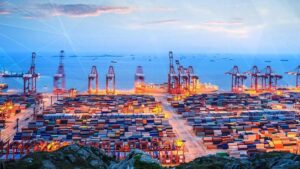The ASEAN Smart Logistics Network (ASLN) is the foundation for promoting logistics linkage and integration in the Association of Southeast Asian Nations (ASEAN).
In addition to improving connectivity among the 10 member countries, ASLN also promotes the use of smart and sustainable logistics infrastructure, supporting the Master Plan on ASEAN Connectivity 2025 – a policy that promotes integration among ASEAN members.

Smart logistics network promotes cooperation among Southeast Asian countries. Photo: Wallup
ASLN was kicked off in November 2020 with the first project named Vinh Phuc ICD Logistics Center (superport) between Singapore and Vietnam. To date, two projects have been started under the ASLN framework, one in Vietnam and one in Cambodia.
ICD Logistics Center Vinh Phuc
The first project under ASLN is Vinh Phuc ICD Logistics Center, located in Vinh Phuc province. Vietnam and Singapore cooperated to launch the center in November 2020 with the attendance of the two countries’ prime ministers.
The project shows the development of an inland container depot and logistics center in Vinh Phuc – what planners call a “superport”. Once completed, this will be one of the largest logistics centers in the North of Vietnam, connecting 20 industrial zones by rail, road and air, as well as connecting with Hanoi, Hai Phong and the province. Yunnan of China.
The project is managed by Vietnam’s T&T Group and Singapore’s YCH Group, attracting more than $166 million in funding.
Phnom Penh Logistics Complex
In March 2021, Cambodia’s Ministry of Transport and Public Works and Singapore’s YCH Group announced a framework agreement to develop the Phnom Penh Logistics Complex in Cambodia. This is the second project started under the ASLN framework.
Under the agreement, Phnom Penh Logistics Complex is designed to be a modern, world-class logistics complex that uses logistics technology to improve resilience, visibility and logistics processes. The project also opens a training academy and start-up center to train Cambodian human resources in the logistics sector.
Like the project in Vietnam, Phnom Penh Logistics Complex aims at the “SuperPort” goal of YCH Group. The project has an estimated cost of 200 million USD and will officially start construction in 2022.
The first two projects under the ASLN reveal trends in future projects and how foreign investors can benefit from them. Notably, both projects have the participation of YCH Group. Although it is unlikely that all ASLN projects will involve YCH Group, it is possible that companies with experience and expertise in more developed markets will be involved.
Non-regional companies can still participate in projects through the provision of consulting services, goods and services. Furthermore, foreign investors can become the main sponsors of ASLN projects.
Foreign businesses operating in the ASEAN region also benefit from the projects, even if they are not directly involved. Given the severe infrastructure shortages in many ASEAN countries, greater regional integration will make logistics cheaper, faster and more efficient, benefiting trade in goods and services within the region. area.
Contribution to the Master Plan on ASEAN Connectivity 2025
The aim of ASLN is to advance the logistics priorities outlined in the Master Plan on ASEAN Connectivity 2025. Logistics is just one area where, with a focus on sustainable infrastructure, digital transformation, transportation transfer…
Regarding logistics, the master plan clearly outlines two strategic goals of reducing costs and improving the speed and reliability of supply chains in each ASEAN member country. To pursue these two strategic goals, the master plan includes two initiatives, namely:
– Enhance ASEAN competitiveness through trade and logistics routes.
– Improve supply chain efficiency by addressing key bottlenecks.
Logistics priorities are also incorporated into other goals in the Master Plan, including building soft infrastructure to support key infrastructure, e-commerce, and providing objective measures of performance. progress and bottlenecks.
However, the Master Plan also notes that previous logistics improvement initiatives in ASEAN have not developed as quickly as planned due to a lack of coordination among agencies. Faced with these challenges, logistics companies must coordinate more, ASEAN member states must identify bottlenecks in the region’s supply chains.





